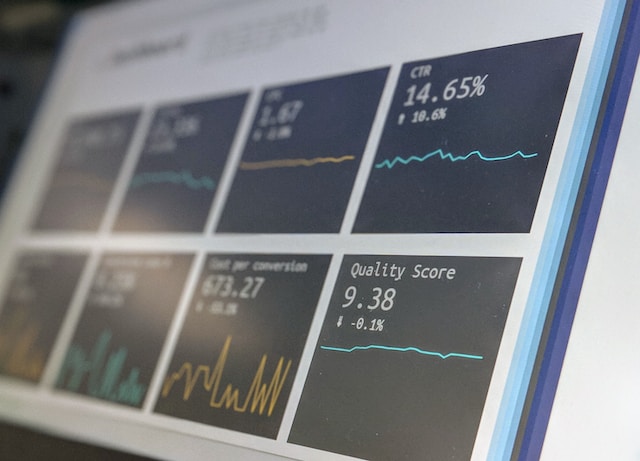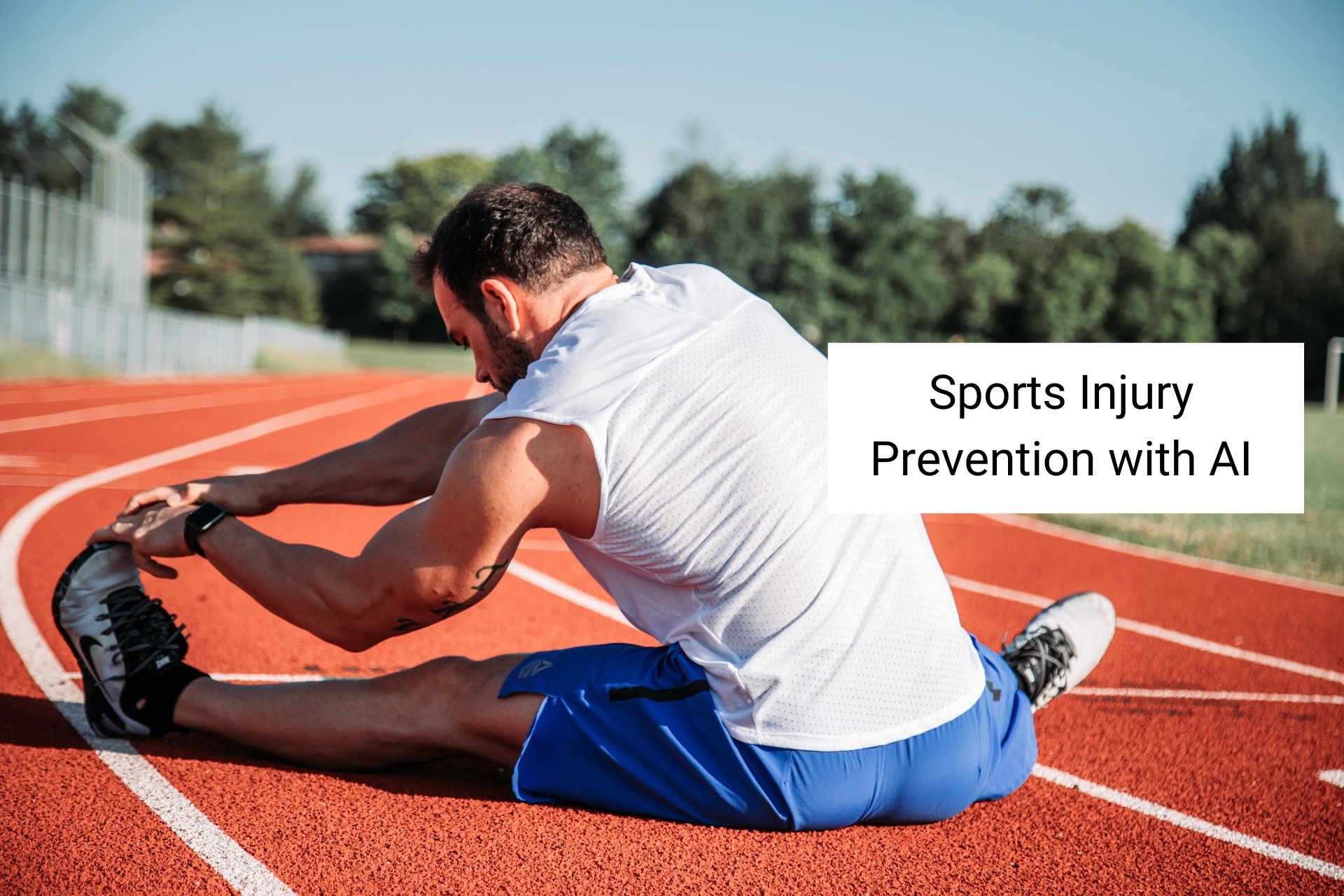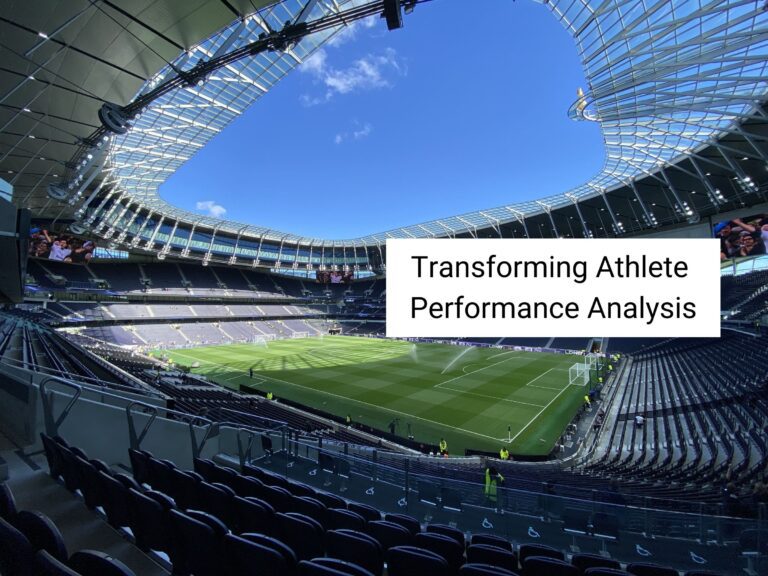Dominate the game: Transforming Sports Injury Prevention with AI
Intro


From an athlete’s point of view, it’s important to stay one step ahead of the game and anticipate potential injuries.
With the help of Artificial Intelligence (AI) technology, sports injury prevention with AI is becoming an increasingly popular and effective way to help athletes stay safe. AI can provide coaches and athletes with insights and data-driven strategies to help prevent injuries and optimise performance. By leveraging AI, athletes and coaches can get ahead of the game and optimise their sports injury prevention efforts.
The Importance of Sports Injury Prevention


Sports injury prevention is of utmost importance for athletes of all levels.
Injuries not only hinder an athlete’s performance, but they can also have long-term consequences on their physical health.
That’s why it’s crucial to prioritise sports injury prevention.
Here we look at a few reasons as to why it’s important:
- Sustaining Active Participation: Injury prevention is paramount in enabling athletes to stay engaged in their sports. Injuries often necessitate periods of rest from training and competition, which can be both disheartening and detrimental to an athlete’s advancement.
- Holistic Well-being: Sports injury prevention is crucial for safeguarding the overall health of athletes. Injuries can leave a lasting impact on an athlete’s physical and mental health, potentially resulting in chronic pain, diminished mobility, and even enduring disabilities. Proactive injury prevention measures can shield athletes from these consequences, enhancing their overall quality of life.
- Career Longevity: Prioritising injury prevention can extend an athlete’s professional career significantly. Many athletes see their careers shortened due to recurring injuries or severe trauma. By giving precedence to injury prevention, athletes can prolong their careers and continue to pursue their passions for an extended period.
- Long-term Investment: Sports injury prevention goes beyond immediate harm avoidance; it’s an investment in an athlete’s long-term health and success. Implementing effective prevention strategies not only shields athletes from potential injuries but also optimises their performance, ensuring a promising future in their respective sports.
Traditional Sports Injury Prevention And Its Limitations


For years, traditional approaches have been the trusted methods for athletes and coaches aiming to safeguard their players’ well-being and performance.
These conventional techniques often involve practices such as stretching, strength training, and injury-specific exercises. While they have demonstrated some effectiveness, they tend to fall short of offering a comprehensive, data-driven strategy for injury prevention.
One of the primary limitations of traditional methods is their reliance on subjective assessments and intuition. Coaches and trainers typically make decisions based on their experience and expertise, occasionally missing subtle warning signs or injury-indicative patterns. Furthermore, traditional approaches often focus on addressing injuries after they’ve occurred rather than proactively preventing them.
Another drawback is their inability to account for the unique needs and characteristics of individual athletes. These approaches often employ a one-size-fits-all approach, disregarding factors such as an athlete’s distinct biomechanics, training history, and injury risk factors. This lack of personalisation can increase an athlete’s vulnerability to avoidable injuries.
How Sports Injury Prevention with AI can be used


Artificial Intelligence (AI) has the potential to revolutionise the way we approach sports injury prevention.
By harnessing the power of AI, athletes and coaches can access a wealth of insights and data-driven strategies to help them stay one step ahead of potential injuries.
One way that sports injury prevention with AI can be utilised is through its ability to analyse vast amounts of data. By examining an athlete’s biomechanics, training load, and injury history, AI can identify patterns and risk factors that may lead to injury. This information can then be used to tailor training programmes and mitigate potential risks.
Additionally, AI can provide real-time feedback and monitoring to athletes and coaches. Wearable devices equipped with AI technology can track an athlete’s performance and detect signs of fatigue or overexertion. This information can help athletes and coaches make informed decisions about when to rest, recover, or modify training sessions to prevent injuries.
Furthermore, AI can contribute to the development of personalised injury prevention programmes. By taking into account an athlete’s unique characteristics and needs, AI can provide individualised recommendations and strategies that are specifically tailored to the athlete. This level of personalisation can greatly enhance the effectiveness of injury prevention efforts.
Overall, sports injury prevention with AI can help by providing athletes and coaches with valuable insights, real-time monitoring, and personalised strategies. By leveraging AI technology, athletes can optimise their training, stay safe, and maximise their performance.
Examples of AI in Sports Injury Prevention


Look at these sports injury prevention with AI examples and applications that showcase its potential.
One notable example is the use of computer vision technology in analysing an athlete’s movement patterns to identify potential risks. By using AI algorithms to track and assess an athlete’s biomechanics, coaches and trainers can pinpoint areas of weakness or improper technique that may increase the risk of injury.
This same approach is being used to transform athlete performance analysis.
This data-driven approach allows for targeted interventions and corrective exercises to be implemented, reducing the likelihood of injury and improving overall performance.
Another example is the use of wearable devices with AI capabilities. These devices, such as smartwatches or fitness trackers, can monitor an athlete’s heart rate, sleep patterns, and other vital signs. By analysing this data in real time, AI algorithms can detect signs of fatigue, overexertion, or abnormal patterns that may indicate an increased risk of injury. Athletes and coaches can then make informed decisions about when to rest, modify training sessions, or seek medical attention to prevent potential injuries.


AI is also being utilised in predictive analytics models, which can assess an athlete’s injury risk based on various factors, such as training load, previous injuries, and environmental conditions. By analysing large amounts of historical data, AI can identify patterns and trends that may indicate an increased likelihood of injury. This information can be used to inform training strategies, adjust training loads, and provide personalised recommendations for injury prevention.
Overall, these examples demonstrate the power of sports injury prevention with AI. By leveraging advanced technologies and data analysis, AI can provide athletes and coaches with valuable insights and personalised strategies to mitigate injury risks and optimise performance. The possibilities for AI in sports injury prevention are endless, and as technology continues to advance, we can expect even more innovative applications in the future.
Strategies for Optimising Sports Injury Prevention with AI


To optimise sports injury prevention with AI, there are several key strategies that athletes and coaches can implement.
Firstly, it’s essential to collect and analyse data. By utilising wearable devices and sensors, athletes can gather information about their biomechanics, training load, and other relevant metrics. This data can then be fed into AI algorithms, which can provide valuable insights and recommendations for injury prevention.
Another strategy is to use AI-powered coaching tools. These tools can provide real-time feedback and monitoring, allowing athletes to make adjustments to their training and technique to minimise the risk of injury. AI can analyse an athlete’s performance data and provide personalised recommendations for optimising their training programmes.
Additionally, integrating AI into injury prediction models can help identify athletes who may be at a higher risk of injury. By considering factors such as training load, previous injuries, and environmental conditions, AI algorithms can provide proactive recommendations for injury prevention.
Lastly, collaboration and communication between athletes, coaches, and sports scientists are crucial for optimising sports injury prevention with AI. By sharing data and insights, athletes and coaches can work together to tailor training programmes and implement injury prevention strategies that are specific to each athlete’s needs.
Challenges and Limitations of Implementing AI in Sports Injury Prevention


Whilst Artificial Intelligence (AI) has the potential to revolutionise sports injury prevention, several challenges and limitations need to be addressed.
One major challenge is the availability and access to high-quality data. AI algorithms rely on large amounts of data to accurately analyse and identify patterns that may lead to injury. However, collecting this data can be time-consuming and expensive, especially for athletes and teams with limited resources.
Another challenge is the need for effective integration and implementation of AI technology into existing training programmes. Coaches and athletes may face resistance or scepticism when it comes to adopting new technologies. It’s important to provide education and training on how AI can enhance injury prevention efforts and demonstrate its effectiveness through real-world examples and success stories.
Privacy and ethical considerations are also important factors to consider. With the collection of sensitive health and performance data, it’s crucial to ensure that the privacy and confidentiality of athletes are protected. Clear guidelines and regulations should be in place to govern the collection, storage, and use of data to prevent any misuse or abuse.
Furthermore, AI technology is not without its limitations. Whilst AI can provide valuable insights and recommendations, it is not a replacement for human expertise and experience. Coaches and trainers still play a crucial role in injury prevention, and AI should be seen as a tool to augment their knowledge and decision-making, rather than replacing it entirely.
Conclusion
In this ever-evolving world of sports injury prevention, Artificial Intelligence (AI) has emerged as a powerful tool that can revolutionise the way athletes and coaches approach injury prevention. By leveraging the capabilities of AI, athletes can gain valuable insights and data-driven strategies to stay one step ahead of potential injuries.
AI has the ability to analyse vast amounts of data, including an athlete’s biomechanics, training load, and injury history. By identifying patterns and risk factors that may lead to injury, AI can provide personalised recommendations and tailored training programmes to mitigate potential risks.
Real-world applications of AI in sports injury prevention, such as computer vision technology and wearable devices have showcased the effectiveness of AI in identifying potential risks and providing real-time feedback to athletes and coaches. By integrating AI into injury prediction models, proactive recommendations can be made to prevent injuries before they occur.
However, there are challenges and limitations that need to be addressed when implementing AI in sports injury prevention, such as the availability and access to high-quality data, effective integration into existing training programmes, privacy and ethical considerations, and the need to recognise that AI is not a replacement for human expertise.
Overall, by harnessing the power of AI, athletes and coaches can optimise their sports injury prevention efforts, protect their bodies, enhance their performance, and secure a bright future in their respective sports. With continuous advancements in AI technology, the possibilities for sports injury prevention are endless, and we can look forward to more innovative applications in the future.





